CHAPTER 36 of THE COOLEST SPOT IN CHICAGO:
A HISTORY OF GREEN MILL GARDENS AND THE BEGINNINGS OF UPTOWN
PREVIOUS CHAPTER / TABLE OF CONTENTS / NEXT CHAPTER
It’s one of the most famous stories about the Green Mill: Entertainer Joe Lewis was performing there in 1927 when he decided to take his show to another venue. The Green Mill’s boss warned him against breaking off his engagement, but he did it anyway. And soon after Lewis left the Green Mill, some thugs beat him up and slashed his face, leaving him for dead. But he survived and made a comeback.
That much of the story is almost certainly true.
But many of the other facts surrounding the assault on Joe Lewis are debatable. Was gangster Jack McGurn responsible for the attack, as the story usually goes? Did McGurn own a share of the Green Mill? And was Al Capone, who employed McGurn, somehow involved in all of this? All of those questions have the same answer: Maybe.
Lewis was called “The Man the Gangsters Couldn’t Kill,”1 capturing the public’s sympathy at a time when Chicago was in the midst of violent battles between mobsters over beer-running and gambling. A 1928 article by the International Feature Service, syndicated in newspapers around the country, summarized the drama that had captivated so many people:
They “ganged” Joe Lewis because he was “good”—the funniest cabaret clown in Chicago. Thin-lipped gangsters left him, as they thought, “ruined” or dead. But thanks to science and his own amazing courage, Joe Lewis is back! He’s still a little shaky on his pins, but the singing voice they tried to destroy is all but restored. Now gangland, Chicago and the world are wondering—will the rats who “took him for a ride” be shaken from their holes?
Chicago has had more than one savage gang crime, but the attack on Joe Lewis made Chicago cry out in horror and rage. He was no gangster, but a good, clean-living boy. Hundreds of persons who did not know him gave money so that the best surgeons could be engaged to mend his horribly mutilated face and body and bring him back from the shadow of death. 2
In the decades that followed, Lewis’s raspy voice and his slight lisp were among his trademarks as a comedian. The New York Times said his voice “sounded like two pieces of sandpaper being rubbed together.” Lewis sometimes joked: “I got a speech impediment. I just can’t seem to say anything funny.”3
He also had a scar on his face.4 When people asked Lewis about it in the 1930s, he was reluctant to tell them the true story of how he got it, so he made up a fib about a car wreck. “I always tell ’em a dark road and the car skidded,” Lewis recalled. “They inevitably toss back some pleasantry about keeping both hands on the wheel and we all have a hearty laugh. They go away in a good humor and come back often. What’s the use telling the truth and making ’em have bad dreams? Bad dreams are bad. I know. I used to have ’em regular.”5
But as time went on, Lewis began telling the nightmarish tale of how he’d received the injuries that scarred his face and his voice. Starting around 1937, dozens of articles in newspapers across the United States recounted the story of Lewis’s dramatic escape from death. Some of these articles quoted interviews with Lewis. Others told the story without directly quoting him. Did those writers even talk with Lewis? It’s possible they were simply rehashing anecdotes they’d heard from publicists or read in other articles. The story’s details weren’t always the same. Was Lewis changing his story? Or were some of these writers making errors? That’s impossible to know.
 The best-known version of the story is sportswriter-turned-screenwriter6 Art Cohn’s 1955 book The Joker Is Wild, which was turned into a 1957 movie starring Frank Sinatra as Joe E. Lewis. It was largely based on Cohn’s interviews with Lewis, but Cohn wrote it more like a novel than a work of journalism or carefully sourced nonfiction. Cohn—who’d started his movie career in 1949 with The Set-Up, another story about an underdog hero standing up to mobsters—called The Joker Is Wild a “dramatized biography,” but he insisted it was true.
The best-known version of the story is sportswriter-turned-screenwriter6 Art Cohn’s 1955 book The Joker Is Wild, which was turned into a 1957 movie starring Frank Sinatra as Joe E. Lewis. It was largely based on Cohn’s interviews with Lewis, but Cohn wrote it more like a novel than a work of journalism or carefully sourced nonfiction. Cohn—who’d started his movie career in 1949 with The Set-Up, another story about an underdog hero standing up to mobsters—called The Joker Is Wild a “dramatized biography,” but he insisted it was true.
“Joe disapproves of many passages,” Cohn wrote. “We are friends, but when truth and friendship were at odds, I chose truth in the name of friendship.”7
The Chicago Daily Tribune’s review criticized the book for “over-dramatizing and sloppy sentimentality” and for its “many factual errors.”8 Decades later, when Jeffrey Gusfield wrote a 2012 biography of Jack McGurn, he lambasted Cohn’s book for telling “a completely false iteration of McGurn’s life” that was “as fanciful and untrue as anything that will ever be written about Jack McGurn.”
Gusfield was highly skeptical of the book’s narrative about the events of 1927, commenting: “Corroborative evidence to Lewis’s claims will never materialize, especially since he co-writes his biography in an alcoholic haze in 1955, after Jack McGurn and Al Capone are long dead and cannot refute the story. … Perhaps it is the serious skull fracture that has clouded his brain and destroyed his memory after the attack, because none of the facts regarding the deadly episode seem to match up.”9
It’s no secret that Lewis drank a lot. When he died in 1971, the New York Times obituary reported: “He drank heavily, gambled heavily, smoked three to four packs of cigarettes a day, and scrupulously avoided exercise. He frequently drew on these real extravagances for his comedy. … With the microphone in one hand and the whisky tumbler in the other, he would wander around the room talking and drinking. ‘He’d come to your table and he’d pour himself a drink, or he’d put his empty glass down and take your drink,’ a fan said.”10
Lewis’s memories of 1927 may have been clouded by all of that drinking—or simply by the passage of time. It’s also possible that the attack itself affected his memory. He had to relearn how to speak after those thugs beat him up, so how much did he really remember about what happened? And like anyone telling stories about their life, Lewis may have chosen to include certain facts and omit others.
The Joker Is Wild does not make it easy to decipher precisely what Lewis told Cohn during those interviews. Cohn took those interviews and transformed them into dramatic scenes. When he presented dialogue—scenes where Lewis spoke with other people, such as McGurn—were all of those words taken verbatim from Cohn’s interviews with Lewis? It’s quite possible, even probable, that Cohn embellished these scenes. The book’s accuracy would be easier to assess if we had transcripts or recordings of exactly what Lewis said. The book does get some facts wrong—including, remarkably, the date when Lewis was attacked.
Even if we accept the gist of Lewis’s story—and The Joker Is Wild—as essentially true, it doesn’t exactly match the legend that’s usually told about these events. Lewis never said that Al Capone hung out at the Green Mill or owned the place. In fact, he said the nightclub was dominated by Capone’s enemies in the North Side mob. And Lewis thought that Jack McGurn was actually working for the North Side mob rather than Capone during the stretch of time when Lewis and McGurn were both at the Green Mill. At least, that’s what The Joker Is Wild seems to suggest, in its somewhat muddled and confusing narrative.
To try solving the puzzle of what happened in 1927, we have to consider the question: When did Jack McGurn start working for Al Capone?
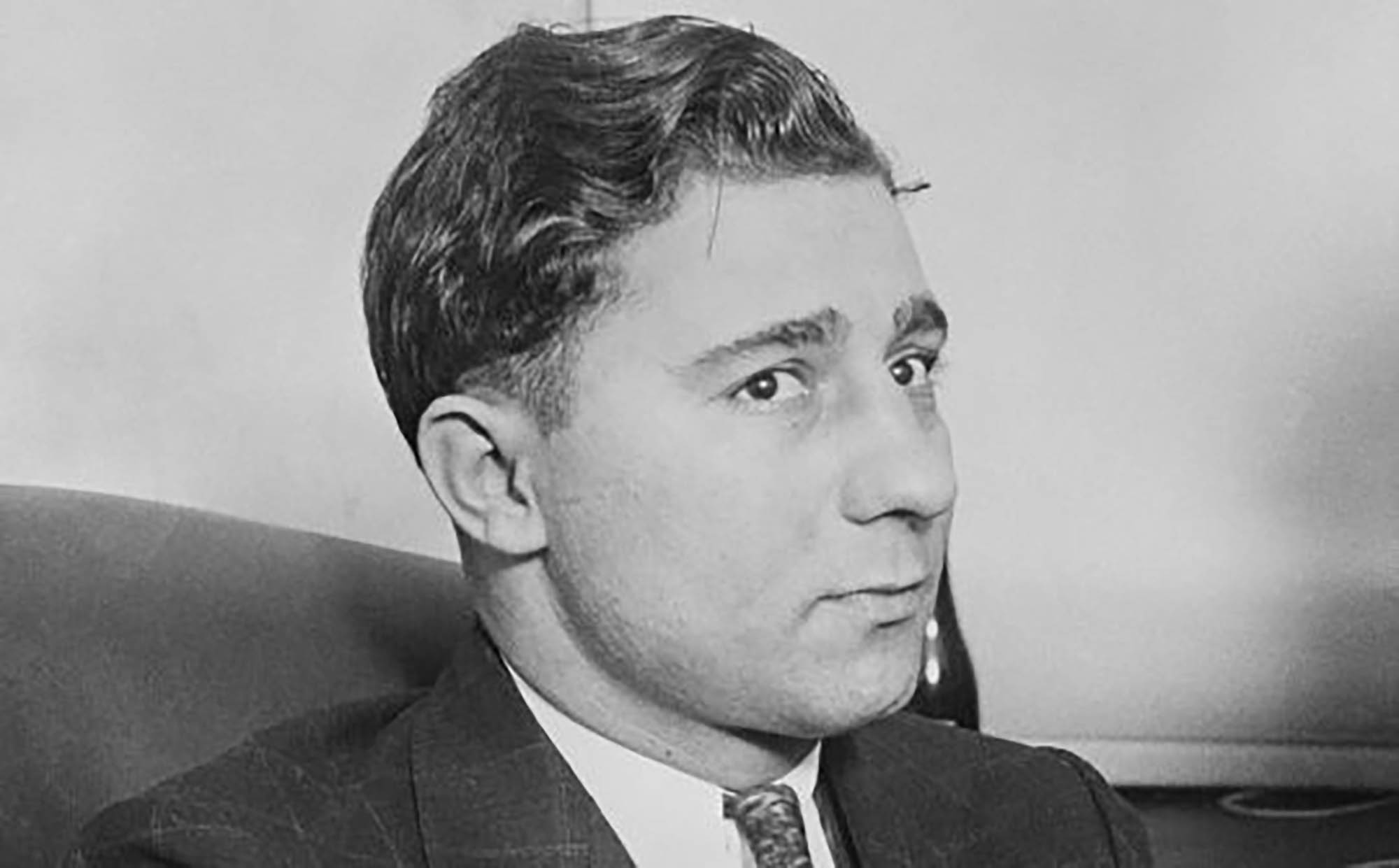
Newspapers usually called him Jack McGurn—and after 1929, they often added “Machine Gun” in front of his name, heightening the sense of menace whenever he appeared in print.11 But he’d been born with the name Vincenzo Gibaldi, in a little Sicilian village called Licata, where his father hauled vegetables and fruits along the island’s coast. The family immigrated to the United States in 1906, when Vincenzo was four years old.12 After growing up in Brooklyn,13 he moved in 1919 with his family to Chicago, living at 571 South Sangamon Street, where many of their neighbors were also Sicilian.14 He started spelling his surname as Gebardi,15 using either Vincent or James as his first name. But when he made his debut as a professional pugilist in 1921, he chose a new moniker for his identity in the boxing ring.
“There are Italian battlers, but they don’t fare so well, so many of them change their names to sound Irish. Vincent Gebardi decides to make his professional name Jack McGurn,” Gusfield wrote in his book, Deadly Valentines: The Story of Capone’s Henchman “Machine Gun” Jack McGurn. “Vincent invents the Irish name, choosing Jack, which is somewhat similar to his ‘real’ name of James, and McGurn because it is the toughest-sounding Irish moniker, having a ‘grrr’ of intimidation in it. … The name Jack McGurn is an almost comical parody of a tough, black Irish stereotype.”16 McGurn won three fights, reached a draw in two, and lost once.17
The police believed McGurn eventually killed as many as 22 people outside of the ring.18 “He was in my court several times, picked up on suspicion of murder,” judge John H. Lyle recalled. “But always the arresting officers lacked evidence that would allow me to hold him to the grand jury.”19 This was the way things usually went when gangsters were hauled into court during the Prohibition Era. McGurn was never convicted of killing anyone.
This reputed killer was a flashy dresser. “McGurn was the complete jazz age sheik, a ukulele strummer, cabaret habitué and snaky dancer,” John Kobler wrote in his book Capone. “An insatiable collector of women, preferably blondes, he parted his curly black hair in the middle and slicked it down with pomade until it lay as flat and sleek as Rudolph Valentino’s. He wore wide-checked suits heavily padded in the shoulders, flower-figured neckties and pointed patent-leather shoes.”20
McGurn may have embarked on his criminal career to take revenge when his stepfather, Angelo DeMory, was shot to death on January 8, 1923.21 According to “underworld gossip” reported later in the Chicago Daily News, McGurn “went berserk for blood” and gave up his boxing career, as he “vowed a vendetta.”22
His stepfather was probably killed by the “Terrible Gennas,”23 a Sicilian mob led by the six Genna brothers. These “alky-cookers” controlled a swath of the Near West Side,24 paying poor Sicilians in the Little Italy neighborhood to brew whiskey with small stills in their homes. They were allies of the Torrio mob, where Capone was a top lieutenant.25
In Gusfield’s telling of the story, McGurn began working as “muscle” for Capone around this time. But there’s little solid information about exactly what McGurn was up to during these years. Gusfield pointed out a long gap in McGurn’s prizefighting appearances—he had no fights between June 1922 and May 1923—and wrote: “The logical conclusion is that he already supplements his unsteady ring income by at least part-time work for Capone.”26 But that’s just conjecture.
Gusfield did offer further reasons to think McGurn was connected with the Torrio-Capone gang during these early years of his supposed criminal exploits, from 1922 to 1926: Police investigators later used forensic testing of guns to identify McGurn as a suspect in some of the gang’s killings during these years.27 (Like virtually every gangland killing during the Prohibition Era, these cases were never officially solved, however.) At times, McGurn used lawyers linked to the Torrio-Capone gang.28 And Gusfield got information from a “source close to the Gebardi family,” though it isn’t clear which details of his book came from that source—or how credible the source was.
The way Gusfield tells the story, McGurn didn’t have to do much sleuthing to figure out who was responsible for his stepfather’s murder. “McGurn knew the identities of the four men who shot down his stepfather soon after the killing,” Gusfield wrote. McGurn’s stepfather had received a threatening Black Hand letter before he was killed, and he’d suspected it was from Orazio “The Scourge” Tropea and his men, a crew working for the Terrible Gennas.29
But three years passed before McGurn exacted his vengeance. What took so long? If he was working for Capone, that might have prevented him from targeting the Genna mob, which was allied with Capone. But there could be other explanations why so much time passed.
During those three years, Chicago erupted into gang warfare. The Gennas started selling alcohol on the North Side, which enraged the leader of the North Side gang, Dean O’Banion. The North Side gang was soon at war with the Gennas and their allies, the Torrio-Capone mob.
The violence escalated after O’Banion was assassinated on November 10, 1924. Afterward, Torrio was shot and severely wounded. He then served some time in jail for prohibition crimes before moving to New York, leaving Capone in charge of his old organization.30 The war raged on: In 1925, 29 people died in bootlegging-related homicides in Cook County, according to historian John J. Binder. The mayhem continued with another 41 killings in 1926.31 These years were when Capone became famous, as newspapers reported on the exploits of the powerful mobster nicknamed “Scarface.”32
In the midst of this war, McGurn killed four men—members of a Genna crew led by Tropea—in February and March 1926 to avenge his stepfather’s murder, according to mob historians.33 “The stepfather was shot to death because he dabbled in alcohol in the old Genna territory and the underworld legend had it that McGurn, lacking definite information as to who had slain him, shot to death two or three extra suspects for good measure,” the Daily News later reported.34 McGurn’s revenge killings earned him a reputation; this killing spree was the original reason why he became “feared in underworld circles,” the Daily News wrote.35
A few weeks after the final revenge killing, the Tribune reported that “James Gebhardt, … formerly a pugilist known as Jack McGurn,” had narrowly missed getting shot while walking in an alley in Little Italy. “Several bullets passed through his hat, but he was unharmed,” the newspaper reported. “He fled after the shooting, but was found by the police several hours later. He could give no explanation of the attack.”36
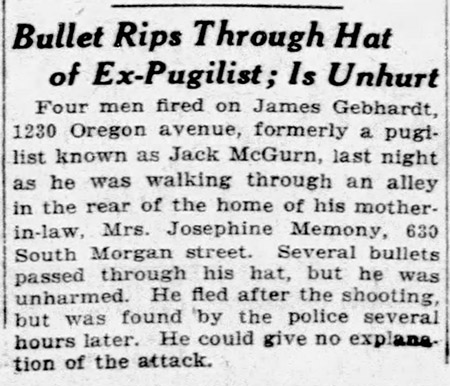
Who was shooting at McGurn? And whose side was he on? If he was working for Capone—as Gusfield asserts—then Scarface may have given his approval for these Genna gang members to die, even if they were ostensibly on Capone’s side of the beer war. “McGurn is no doubt thrilled on getting word from Al Capone that the very men he wants to kill the most are sanctioned for death,” Gusfield wrote.37
These killings—which McGurn allegedly committed with another mobster, Johnny Armando—weakened the Genna gang. “Capone would not have been especially sorry to see the Gennas go,” Binder wrote in Al Capone’s Beer Wars. “When, with his help, their gang collapsed, he took over the important Taylor Street area.”38
However, other sources say McGurn wasn’t working yet for Capone. The 1930 book Chicago Gang Wars in Pictures: X Marks the Spot claimed that McGurn was getting money and support from someone else: “One of the wealthy and influential Italians was behind Jack now. This individual whom we shall not name had revealed to Jack the name of his father’s slayer, and Jack quickly agreed to the proposals held out to him.”39
This book was published anonymously, but it was later revealed to be the work of Harold “Hal” Andrews,40 an editor who worked at various times for the City News Bureau, the United Press, and the Chicago Herald and Examiner.41 It’s written in a sensationalist tone and it rarely bothers to cite the sources of its stories, but Andrews’s experience in Chicago’s newsrooms gives it some credibility.42
It’s curious that X Marks the Spot concealed the identity of McGurn’s supposed benefactor, while revealing so much about other gangland figures. Whoever this “wealthy Italian on the West Side” was, it seemed to be someone who feared reprisals from Capone. That’s supposedly why he spent $25,000 to get McGurn, who was “his ambitious protégé,” a job as a chauffeur for Earl “Hymie” Weiss, who’d succeeded Dean O’Banion as the North Side gang’s top boss.43
Maybe that anonymous wealthy Italian worried that McGurn’s revenge killings would stir up too much trouble in Capone’s part of town, so it was best to send McGurn somewhere else. It’s also conceivable that McGurn had already been working with the North Side gang for a while. After all, he was seeking revenge on the Gennas. And the Gennas were at war with the North Side gang. That made McGurn a natural ally of the North Siders.
According to the Daily News, McGurn joined the North Siders after he committed those revenge killings in early 1926. “His prowess as a killer won him a place in the … north side gang,” the newspaper said.44 But a different Daily News story offered another chronology, reporting that McGurn had been a member of the North Side mob’s “standing army” since 1924, a year after his stepfather’s death.45 Meanwhile, the Chicago Evening American called McGurn a “former lieutenant of the slain Dean O’Banion.” For that to be true, McGurn must have been in the gang sometime before O’Banion was killed in November 1924.46
In Binder’s book, the historian offers this chronology: “A variety of evidence indicates that ‘Machine Gun’ Jack McGurn went with the North Siders after he finished his vengeance in February 1926, because it was feared there would be reprisals against him by the Gennas. … However, McGurn quickly fell out with the Weiss crowd and he may have been with the Capone gang as early as April 1926.”
Binder based that conclusion on ballistics evidence. The police later confiscated a machine gun from McGurn, and ballistics tests linked it to bullets found in a number of homicide victims—including assistant state’s attorney William McSwiggin and West Side bootlegger Jim Doherty, who were both killed (along with Thomas Duffy) in Cicero on April 27, 1926, with suspicion immediately falling on the Capone mob.47 Of course, it’s possible that ballistics report was wrong. Or that someone else had used the same weapon. Or that McGurn committed these killings but didn’t do it on Capone’s behalf. Or that McGurn was a freelance hit man.
The bloody war between Capone’s outfit and the North Side mob reached a climax when Weiss—who’d supposedly employed McGurn as a chauffeur—died in a burst of machine gun and shotgun fire on October 11, 1926, outside Schofield’s Flowers at 738 North State Street, the same spot where O’Banion had been killed two years earlier.48 Some of the bullets scarred the cornerstone of Holy Name Cathedral, across the street from the flower shop.49
Based on ballistics evidence, Chicago police detectives later believed McGurn wielded the machine gun.50 And Gusfield described McGurn as the head assassin. If this is true, McGurn must have switched sides to Capone’s gang by this time. Or, as Gusfield asserted, McGurn had been with the Capone mob all along. Or was McGurn a sort of double agent—working with the North Siders while surreptitiously targeting their leader? It’s also possible the evidence was wrong and McGurn had nothing to do with this shooting.
According to Gusfield, McGurn rented two apartments overlooking the intersection and staked out the area for weeks. As Weiss and four other men crossed the street, McGurn and another gunman opened fire. Ten bullets hit Weiss, killing him instantly. Another mobster, Paddy Murray, was hit by 15. “Such precision became another of McGurn’s signatures, an impressive accuracy with the hard-to-control submachine gun,” Gusfield wrote.51
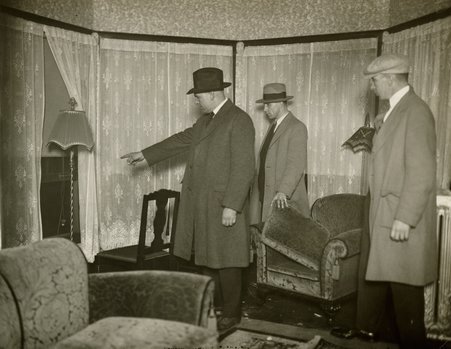
Three hours after Weiss’s death, Chicago Herald and Examiner reporter Patricia Dougherty interviewed Capone at a hotel in Cicero. “That killing today was unnecessary,” Capone said, speaking calmly and quietly. “I told Hymie time and again it was foolish for his North Side mob not to be friends with us in Cicero. But he was too bull-headed to listen. So he got killed. I’m ready to make peace any time. The only people we have to fear are each other. There’s plenty of business for all of us. … Now if any of his mob that’s left wants to make peace with me, I’m still ready. Tell them that, will you?”
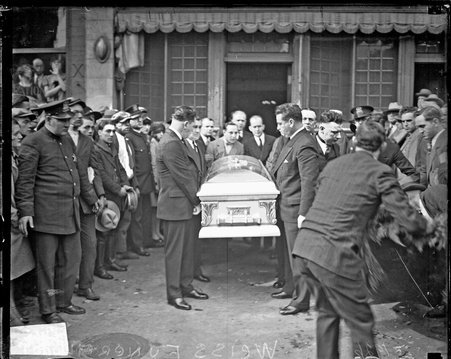
On October 20, the warring gangs sat down for a peace conference at downtown’s Sherman Hotel.52 “It was just like old times,” Capone told Dougherty after coming out of the meeting. “We talked about the old days when we were all in one happy mob together and we agreed that from now on whenever anything comes up that makes us mad, we’ll call up the other fellow and talk it over. They’re going to stay on the North Side and I’m going to stay in Cicero and if we meet on the street, we shake hands and say hello, and everything’s dandy.”53

At this peace conference, Capone reportedly made a deal with the North Siders’ new leader, George “Bugs” Moran, to “discharge” some of their “soldiers,” the Daily News reported. According to the newspaper, this was the moment when McGurn switched his allegiance: “McGurn, let go by Moran’s mob, found employment with ‘Scarface Al’ Capone.”54 A separate Daily News story offered another explanation for why McGurn left his job as a “gun bearer in the Weiss-Drucci-Moran outfit”—it was because he could earn “higher pay” with the Capone outfit, the article said (without saying exactly when this happened).55
The two sides also chose Madison Street as their official dividing line. Conveniently, the street also happened to be Chicago’s official demarcation between streets with “North” and “South” addresses. “It was agreed that Madison Street … would mark off the territory of the two factions,” a former bootlegger anonymously told the International News Service. “Capone and his ring were to be supreme south of Madison Street from the lake to the city limits. North of Madison, the old O’Banion gang and their allies were to operate.” 56
This marked the beginning of a truce, and the violence subsided—at least for a while. The shaky peace took effect just as the Green Mill was preparing to reopen in the North Side mob’s territory. On November 17, the New Green Mill Cafe made its public debut, featuring Joe Lewis as the master of ceremonies.57
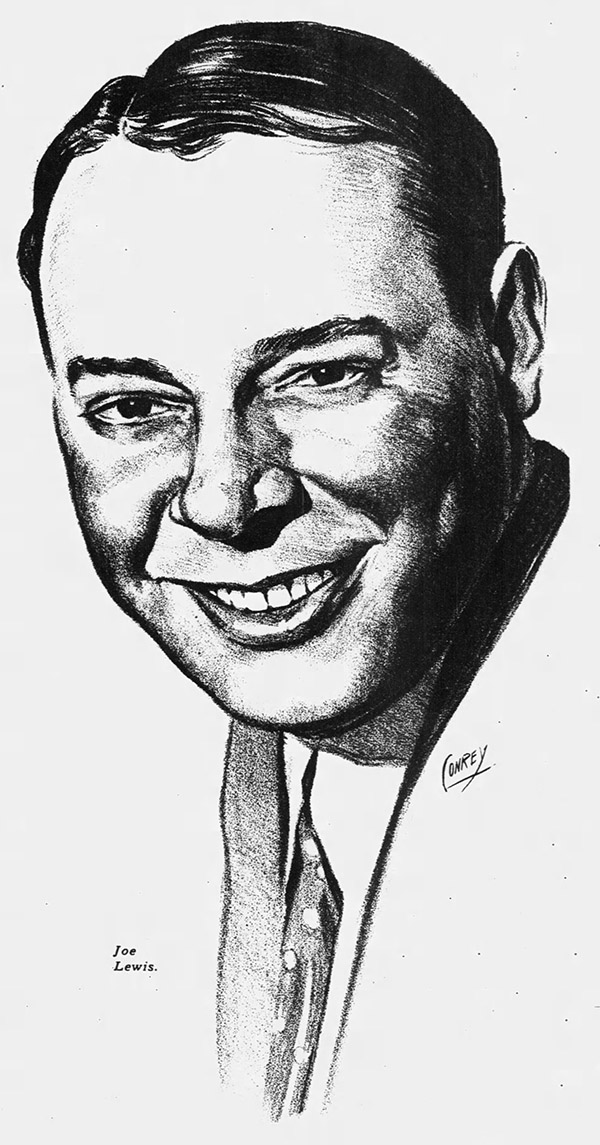
During his time at the Green Mill, he was known simply as Joe Lewis. A decade later, he added the middle initial “E.” to his stage name, so people wouldn’t get him mixed up with the boxer Joe Louis.58 At various times, Joe E. Lewis told people that the “E” stood for “Everloving,” “Everything,” “Enything,” or—if he happened to be performing in Florida—“Everglades.”59 His actual name, when he was born in Manhattan’s Lower East Side60 in 1902, was Joseph Klewansky or Klewan. His father, a Russian Jewish immigrant working as a cork maker, died when Joe was 12.61
When Joe was still in his teens, he began performing as an entertainer in burlesque shows.62 “I had a swell alto voice,” he recalled.63
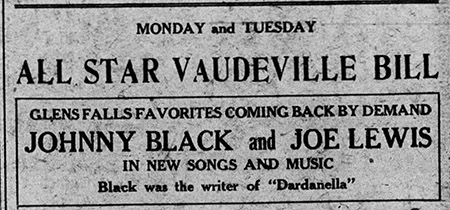
He formed a “comedy songs and patter” duo with the alcoholic piano player Johnny Black,64 who’d co-written “Dardanella,” one of the era’s most popular songs.65 “When Joe was not trying to sober him sufficiently to lead him on the stage and prop him on the piano bench, he was rescuing him from homicide at the hands of jealous husbands,” Cohn wrote in The Joker Is Wild.66 (A decade after their partnership ended, Black died when someone cracked his skull during a fight over 25 cents at a roadhouse that Black owned in Ohio.67 Black posthumously had a second hit when the Mills Brothers recorded his song “Paper Doll.”68)
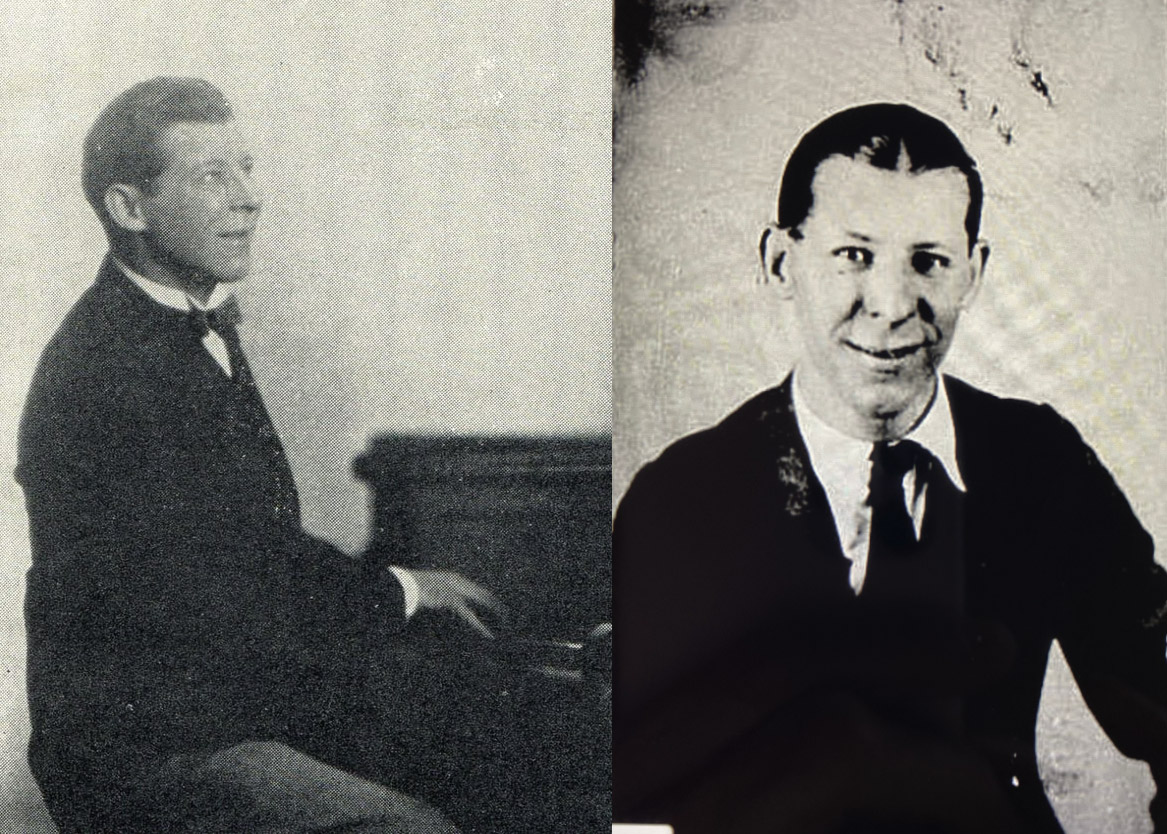
When the duo split up in 1925, Lewis found himself stranded in Chicago. Producer Roy Mack hired Lewis to sing at the Midnight Frolics—sometimes simply known as the Frolics—a legendary nightclub at 18 East 22nd Street. An advertisement in Variety called the Frolics “America’s Most Beautiful Cafe,” also noting that it was “The Rendezvous of the Theatrical Stars” as well as “Civic and Political Celebrities.”69 Formerly called Freiberg’s dance hall, it was in Chicago’s old red-light district, the Levee. For many years, it had been a rendezvous “where ladies of the evening met their mates for an hour a night,” Mack recalled in 1955. It was now the most popular cabaret in a South Side nightlife zone ruled by Al Capone.
“No flagrant crime was ever committed there, I think, in spite of its ill repute,” Mack wrote in a Chicago Daily Tribune magazine article. “The prohibition laws were steadily violated, but offensive drunken behavior was quelled with skill.”70 The Daily News, however, reported that the Frolics was “the scene of half a dozen bombings, shootings, kidnapings and other gangland operations” after it was sold in 1924 by its longtime major-domo, Isaac Gitelson (a.k.a. Ike Bloom). 71
The new owners included Jacob Herman “Jakie” Adler,72 who’d been a political lieutenant of the famously corrupt alderman Michael “Hinky Dink” Kenna.73 Adler later appeared on an organizational chart of Capone’s mob, published by the Tribune. The chart also included “Ralph Gillette.”74 That was actually Ralph Gallet (born Raffaele Galasso75), a part-owner of Frolics who managed the nightclub.
According to Mack, Capone also owned a share of Frolics, under his favorite alias, Al Brown. But when the feds sued the Frolics for violating prohibition laws, they didn’t list Brown or Capone among the proprietors.76 If he really was a part-owner, he didn’t seem to be doing a great job of protecting the place. Two of the owners were robbed of $20,000 in the cabaret’s office in December 1924, a theft they chose not to report to police.77 And the Frolics was the target of at least three bombings in 1925 and 1926, the years when Lewis performed there. (It’s not clear if Lewis was present when the bombs went off.) In two of these incidents, explosions shattered the cabaret’s windows as people were dancing inside, setting off a panic. Women ran out into the street, screaming in terror. Police believed that the nightclub’s business competitors were trying to frighten off its patrons.78 Or was Capone himself the target of those bombs?
When Roy Mack hired Joe Lewis, he was impressed by the 23-year-old’s singing. “In addition to his songs and patter to piano accompaniment, he worked in most of the costumed chorus numbers, such as ‘I Miss My Swiss,’” Mack recalled. Mack decided to make him the master of ceremonies, but Lewis was reluctant at first to do that job. “He shied away from it … until one night I asked him to stand at the head of the gallery stairway when the overture began,” Mack wrote. “Then I shoved him down the stairs for a ceremonial entrance.”79
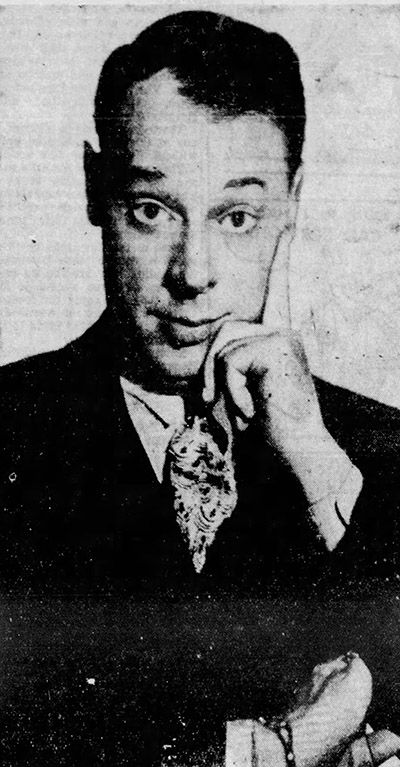
Lewis did four shows a night, starting at a salary of $115 a week.80 “He ‘found’ himself as a master of ceremonies and an all-round floor attraction,” the International Feature Service wrote. “A good floor comedian must know how to handle a crowd at close range. He is right with his audience, he must know how to be easy and casual with his patter, he must make friends easily and be quick on the verbal come-back, he must be able to put over a song under the most difficult conditions imaginable—when his audience is intent on food, drink and chatter. The comedy kid did that and more.”
He had a certain charisma that won people over. “Lewis had the face of a young, smiling Buddha, and it was his fortune,” the same writer observed. “They say he knew more Chicagoans by their first names than any other man in the city.”81
Lewis hadn’t initially planned to work very long at the Frolics, thinking he’d head back to New York after he’d made enough money for train fare. But he ended up staying for a year, as he came to appreciate the perks of working in a café: “eat for nothing, drink for nothing, and get paid, too,” as Lewis later put it.82
According to The Joker Is Wild, Capone and his bodyguards stopped by Lewis’s table inside the Frolics early one morning. “I hear you got a good act,” Capone supposedly told him. “Save me a table tomorrow night.”
Soon after that, “Capone became a regular customer at the Frolics,” Cohn wrote. “… Joe made the Big Guy laugh. There were not many who could.”83 According to John Kobler’s 1971 book Capone, the gangster “would turn up two or three nights a week to hear Joe E. Lewis sing, … stamp his feet to the rhythms of Austin Mack and his Century Serenaders, and drink whiskey out of a teacup. He seldom brought women with him, and he never danced.”84
During the year Lewis worked at the Frolics, he did not seem to have an exclusive, year-round contract at the nightclub. He sometimes performed at movie theaters including McVicker’s and the Rialto,85 whose ad hyped Lewis as “A Breath of Fresh Air.”86 He was also on the billing for several weeks at Club Avalon,87 at 518 West Diversey Parkway. (That was in the same North Side neighborhood where Lewis would fatefully end up performing in late 1927.) The Avalon “claimed to do most of the saxophoning for that part of the Gold Coast which gets restless from midnight till dawn,” the Tribune wrote.88
Variety reviewed several Frolics shows featuring Lewis, praising him as a “first class” master of ceremonies who “certainly tries his best to ‘sell’ the other acts.”89 He “excels in ad libbing,” Variety wrote, noting that Lewis “works hard and is a strong drawing card.”90 One Frolics ad featured what seemed to be a comic catchphrase for Lewis: “SO, WHAT!”91 Variety reported that Lewis was “in constant demand,” with a reputation that earned him “important money.”92
According to The Joker Is Wild, Capone showed up one night, walking over to a table where Lewis was talking with Frolics co-owner Ralph Gallet. Capone seemed to know already what they were discussing. They’d been wrangling over how much money Lewis should be paid. Capone acted like Gallet wasn’t even there. Looking at Lewis, he asked: “Are you having trouble with Gallet?” (Cohn’s book misspelled “Gallet” as “Gillette,” which I’ve corrected in these quotations.)
“No, Al, everything is OK,” Lewis said.93
His face darkening, Capone said, “If Gallet gives you any trouble, you tell me.”
Gallet was paralyzed with fear, but he finally spoke up: “What kind of trouble could there be? We just decided to give Joe a raise … a nice raise. You said three hundred, didn’t you, Joe boy?”
“I said four hundred, Ralph—per week.”
Smiling apologetically, Gallet said, “Of course, Joe boy. And four hundred it is.”
Still ignoring Gallet, Capone told Lewis: “If Gallet gives you any trouble, Joe, I’ll be your partner. You can pick out any joint in the Loop. I’ll give you fifty G’s to open and I don’t want a nickel profit.”
“Thanks, Al, but I think I’ll stick with the Frolics,” Lewis said. “For a while, anyway.”
“The fifty’s ready any time,” Capone said, walking out.
Lewis then told Gallet, “That’s the second offer I’ve had this week. Danny Cohen wants me up on the North Side.” Swallowing hard, Gallet told him, “Go as far north as you can.”94
At least, that’s how The Joker Is Wild told the story. Why would Gallet want Lewis to go far away? He may have been frightened that Capone would take Lewis’s side in future conflicts, leading Gallet to conclude that it would be safer if Lewis went somewhere else. Or maybe he just couldn’t afford to pay Lewis as much as Capone insisted. But it’s hard not to question Gallet’s wisdom. Wouldn’t he risk angering Capone if he allowed the Frolics to lose one of the mob boss’s favorite entertainers?
When Lewis said he’d received an offer from Danny Cohen, he was talking about a part-owner of the Montmartre Cafe,95 which occupied the former Green Mill Gardens space at 4806 North Broadway until a federal judge shut it down in May 1926. Cohen was now preparing to reopen it as the New Green Mill Cafe. Cohen was also running the Lighthouse, a roadhouse and gambling establishment at Dempster Street and Waukegan Road in north suburban Morton Grove.96 According to some reports, Lewis initially left the Frolics to perform at the Lighthouse, before moving to the New Green Mill.97 Roy Mack recalled the New Green Mill offering Lewis $500 a week. “The Frolics matched the Green Mill offer, but Joe wanted a change of base and would not change his mind,” Mack wrote.98
Variety reviewed one of Lewis’s final shows at the Frolics, on October 4, 1926, when a big crowd turned out. “Ropes had to be put up to keep out the overflow,” the newspaper reported. “People were standing around in any available apace waiting for a table. Show people were very much in evidence, easily comprising the majority of the crowd.” In the midst of it all, Lewis introduced every entertainer he spotted sitting in the crowd, including Sophie Tucker, the singer-comedian known as “The Last of the Red-Hot Mamas,” who roused the audience with a couple of songs. “Joe Lewis, in a new suit and singing new songs, held everything all through the evening,” Variety reported. “Joe has been here now over a year and from the reception accorded him he can stay a couple of more. He lands laughs all over the place and never seems to slow up.”99
On November 10, Variety reported that Lewis was taking a vacation, heading to New York for a week or two.100 But one week later, he appeared as the new master of ceremonies at the Green Mill.101
PREVIOUS CHAPTER / TABLE OF CONTENTS / NEXT CHAPTER
Footnotes
1 Art Cohn, The Joker Is Wild: The Story of Joe E. Lewis (New York: Random House, 1955; New York: Bantam, 1957), 62.
2 International Feature Service, “How Science Saved the Comedy Kid the Gangsters ‘Got,’” Salt Lake Tribune, January 29, 1928, magazine, 3.
3 McCandlish Phillips, “Joe E. Lewis, Nightclub Comic Noted for Garrulousness, Dies,” New York Times, June 5, 1971, https://timesmachine.nytimes.com/timesmachine/1971/06/05/79706009.html?pageNumber=32.
4 Bob Musel, United Press, “Big Town Medley,” Suffolk (VA) News-Herald, September 17, 1941, 4.
5 Allan Keller, “Comedian Enjoys Making Them Laugh, But Gangsters Almost ‘Froze’ His Smile,” Evansville (IN) Press, June 11, 1937, 27.
6 Luther Nicholas, “Joe E. Lewis Offstage,” San Francisco Examiner, October 21, 1955, section 3, 3; Cohn, Joker Is Wild, 54.
7 Cohn, Joker Is Wild, vi.
8 Richard Blakesly, “What They Go Thru Just to Watch Him!” Chicago Daily Tribune, October 30, 1955, part 4, 9.
9 Jeffrey Gusfield, Deadly Valentines: The Story of Capone’s Henchman “Machine Gun” Jack McGurn (Chicago: Chicago Review Press, 2012), 131–132.
10 McCandlish Phillips, “Joe E. Lewis, Nightclub Comic Noted for Garrulousness, Dies,” New York Times, June 5, 1971, https://timesmachine.nytimes.com/timesmachine/1971/06/05/79706009.html?pageNumber=32.
11 The earliest instances I’ve found of his “Machine Gun” nickname appeared when he was suspected in the St. Valentine’s Day Massacre of 1929. An early example: “Henchmen of Capone Held for Killing,” Coshocton (OH) Tribune, March 2, 1929, 1.
12 Gusfield, Deadly Valentines, 11, 13, 16, 17.
13 Gusfield, Deadly Valentines, 23.
14 Gusfield, Deadly Valentines, 30.
15 Gusfield, Deadly Valentines, 28.
16 Gusfield, Deadly Valentines, 38.
17 Gusfield, Deadly Valentines, 69.
18 John Kobler, Capone: The Life and World of Al Capone (New York: G.P. Putnam’s Sons, 1971), 144.
19 John H. Lyle, The Dry and Lawless Years: The Crusade Against Public Enemies and Corrupt Officials in Chicago (Englewood Cliffs, NJ: Prentice-Hall, 1960), 206.
20 Kobler, Capone, 144.
21 Gusfield, Deadly Valentines, 59.
22 “Gangland Fears M’Gurn Reprisal,” Chicago Daily News, April 19, 1928, 4.
23 Gusfield, Deadly Valentines, 62.
24 John J. Binder, Al Capone’s Beer Wars: A Complete History of Organized Crime in Chicago During Prohibition (Amherst, NY: Prometheus, 2017), 100–101.
25 Laurence Bergreen, Capone: The Man and the Era (New York: Simon & Schuster, 1994), 129–130.
26 Gusfield, Deadly Valentines, 52.
27 Gusfield, Deadly Valentines, 97.
28 Gusfield, Deadly Valentines, 101.
29 Gusfield, Deadly Valentines, 309.
30 Jonathan Eig, Get Capone: The Secret Plot That Captured America’s Most Wanted Gangster (New York: Simon & Schuster, 2010), 33–34, 36.
31 Binder, Al Capone’s Beer Wars, 276.
32 Eig, Get Capone, 39.
33 Gusfield, Deadly Valentines, 92-96.
34 “M’Gurn Slain, Police Say,” Chicago Daily News, July 17, 1933, 1.
35 “Machine Gun Spray Laid to Capone’s North Side Invasion,” Chicago Daily News, March 8, 1928, 1, 4.
36 “Bullet Rips Through Hat of Ex-Pugilist; Is Unhurt,” Chicago Daily Tribune, March 30, 1926, 1.
37 Gusfield, Deadly Valentines, 92.
38 Binder, Al Capone’s Beer Wars, 156–157.
39 Anonymous (Harold “Hal” Andrews), Chicago Gang Wars in Pictures: X Marks the Spot (Rockford, IL: Spot Publishing, 1930), https://archive.org/details/chicagogangwarsi00rock, 26.
40 Michael Heminger, Amazon review, January 9, 2020, https://www.amazon.com/Marks-Spot-Chicago-Gang-Pictures/dp/B000NOAG84; inscription on inside cover at https://archive.org/details/chicagogangwarsi00rock/page/n1/mode/2up.
41 Obituary, Chicago Daily Tribune, March 16, 1961, 52.
42 Chicago Gang Wars in Pictures, 1.
43 Chicago Gang Wars in Pictures, 30.
44 “M’Gurn Slain, Police Say,” Chicago Daily News, July 17, 1933, 1.
45 “Gangland Fears M’Gurn Reprisal,” Chicago Daily News, April 19, 1928, 4.
46 “Joe Lewis Accuses ‘Tony R.’ as Stabber,” Chicago Evening American, Nov. 9, 1927, 1, 9.
47 Binder, Al Capone’s Beer Wars, 145, 159; Ron Grossman, “At the Dawn of the Al Capone era, Prosecutor William McSwiggin Was Killed in a Hail of Machine Gun Bullets Outside a Cicero Tavern,”
Chicago Tribune, January 7, 2024, https://www.chicagotribune.com/history/ct-vintage-mcswiggin-murder-20240107-je4jpt2mzfd6bcj3ypnmp5vwve-story.html.
48 “Hymie Weiss,” Wikipedia, accessed January 11, 2024, https://en.wikipedia.org/wiki/Hymie_Weiss; “Schofield Flowers,” Wikipedia, accessed January 11, 2024, https://en.wikipedia.org/wiki/Schofield%27s_Flowers.
49 Get Capone, 77.
50 Binder, Al Capone’s Beer Wars, 171.
51 Gusfield, Deadly Valentines, 110–112.
52 Bergreen, Capone, 213–216.
53 Patricia Dougherty, “Girl Reporter Gives a Startling Account of Chicago Booze Ring,” Sheboygan (WI) Press, March 16, 1927, 4, 11, reprinted from Cosmopolitan (possibly based on a March 9, 1927, Chicago Herald and Examiner article).
54 “Gangland Fears M’Gurn Reprisal,” Chicago Daily News, April 19, 1928, 4.
55 “Machine Gun Spray Laid to Capone’s North Side Invasion,” Chicago Daily News, March 8, 1928, 1, 4.
56 International News Service, “More Slayings Due in Chicago Gangster War,” Lancaster (PA) Daily Intelligencer, December 2, 1927. A version of the same article is credited to Francis F. Healy in Bayonne (NJ) Times, December 2, 1927, 5.
57 “Fun Spots Around Town,” Chicago Daily News, November 13, 1926, 29.
58 McCandlish Phillips, “Joe E. Lewis, Nightclub Comic Noted for Garrulousness, Dies,” New York Times, June 5, 1971, https://timesmachine.nytimes.com/timesmachine/1971/06/05/79706009.html?pageNumber=32.
59 Herman J. Bernfeld, “Rough Sea,” Cincinnati Enquirer, November 14, 1937, section 3, 1; Samuel Lesner, “Hildegarde and Joe E. Lewis Arrive Jan. 7, Downey Next Day,” Chicago Daily News, January 2, 1943, 10; Roy Mack, “The Night the Mob ‘Got’ Joe E. Lewis,” Chicago Daily Tribune, Nov. 27, 1955, magazine, pp. 22-23.
60 Mel Heimer, “My New York,” (Valparaiso, IN) Vidette-Messenger, November 24, 1948, 1.
61 Tomcgrath, Klewansky Family Tree, accessed January 19, 2024, Ancestry.com; 1910 U.S. Census, New York, New York, Manhattan Ward 11, District 0248, sheet 17A, Ancestry.com; “Abraham Klewansky,” Find a Grave, accessed January 19, 2024, https://www.findagrave.com/memorial/111883636/abraham-klewansky.
62 McCandlish Phillips, “Joe E. Lewis, Nightclub Comic Noted for Garrulousness, Dies,” New York Times, June 5, 1971, https://timesmachine.nytimes.com/timesmachine/1971/06/05/79706009.html?pageNumber=32.
63 Samuel Lesner, “Hildegarde and Joe E. Lewis Arrive Jan. 7 , Downey Next Day,” Chicago Daily News, January 2, 1943, 10.
64 Danton Walker, “Broadway,” Tampa Tribune, June 7, 1939, 4.
65 “Dardanella,” Wikipedia, accessed January 12, 2024, https://en.wikipedia.org/wiki/Dardanella.
66 Cohn, Joker Is Wild, 38.
67 “Johnny Black Dies of Injury Suffered in Fight,” Hamilton (OH) Journal-Daily News, June 9, 1936, 14.
68 “Paper Doll (Mills Brothers Song),” Wikipedia, accessed January 12, 2024, https://en.wikipedia.org/wiki/Paper_Doll_(Mills_Brothers_song).
69 Advertisement, Variety, July 21, 1926, 51, https://archive.org/details/variety83-1926-07/page/n163/.
70 Roy Mack, “The Night the Mob ‘Got’ Joe E. Lewis,” Chicago Daily Tribune, Nov. 27, 1955, magazine, pp. 22-23.
71 “Midnight Frolics Ordered Locked,” Chicago Daily News, May 7, 1928, 1; “Ike Bloom Out of Freiberg’s Famous Hall,” Chicago Daily Tribune, May 11, 1924, 4.
72 U.S., World War I Draft Registration Cards, 1917-1918, Ancestry.com.
73 “Indict for Vote Frauds,” Chicago Daily Tribune, October 28, 1906, 2.
74 Guy Murchie Jr., “Capone’s Decade of Death,” Chicago Daily Tribune, February 9, 1936, part 7, 1.
75 Thomershere, Galasso Family Tree, accessed January 20, 2024; New York, New York, U.S., Index to Birth Certificates, 1866-1909, Ancestry.com.
76 “Dry Writs Hit 28 Cafes, Stars of the Night Life,” Chicago Daily Tribune, October 29, 1927, 5.
77 “2 Missing Owners of Frolics Hunted,” Chicago Daily News, April 16, 1927, 5.
78 “Midnight Frolics Ordered Locked,” Chicago Daily News, May 7, 1928, 1; “Also a Bomb,” Chicago Daily Tribune, January 31, 1926, 2; “‘Noiseless Bomb’ Is Mystery,” Chicago Daily News, March 6, 1926, 1; “Bomb Thrown From ‘L’ Train Damages Frolics,” Chicago Daily Tribune, July 29, 1926, 12; “Cabaret Patrons Routed by Black-Powder Bomb,” Chicago Daily News, July 29, 1926, 5.
79 Mack, “Night the Mob ‘Got’ Joe E. Lewis.”
80 Cohn, Joker Is Wild, 30.
81 “How Science Saved…”
82 Clarissa Start, “Man Who Got Custody of Bookmakers,” St. Louis Post-Dispatch, September 9, 1948, (Everyday Magazine), 3F.
83 Cohn, Joker Is Wild, 31.
84 Kobler, Capone, 230.
85 Advertisements, Chicago Daily Tribune, September 8, 1925, 26; January 13, 1926, 27; January 20, 1926, 26; January 25, 1926, 16; April 20, 1926, 34.
86 Advertisement, Chicago Daily Tribune, January 25, 1926, 16.
87 “Cabaret Bills: Chicago,” Variety, May 26, 1926, 52, https://archive.org/details/variety82-1926-05/page/n235/; June 2 1926, 46, https://archive.org/details/variety83-1926-06/page/n83/; July 21, 1926, 47, https://archive.org/details/variety83-1926-07/page/n159/; August 11, 1926, 57, https://archive.org/details/variety84-1926-08/page/n103/.
88 “Rum Padlocks on Avalon Cafe and 40 Others,” Chicago Daily Tribune, August 24, 1926, 1.
89 “Cabaret Reviews: Frolics,” Variety, July 21, 1926, 46, https://archive.org/details/variety83-1926-07/page/n157/.
90 “Cabaret Reviews: Frolics,” Variety, September 1, 1926, 47, https://archive.org/details/variety84-1926-09/page/n45/.
91 Advertisement, Variety, July 21, 1926, 51, https://archive.org/details/variety83-1926-07/page/n163/.
92 “Cabaret Reviews: The Frolics,” Variety, April 14, 1926, 41, https://archive.org/details/variety82-1926-04/page/n105/.
93 Cohn, Joker Is Wild, 31.
94 Cohn, Joker Is Wild, 32.
95 “Chicago,” Variety, April 22, 1925, 14, https://archive.org/details/variety78-1925-04/page/n197/mode/2up; Montmartre Cafe Inc. corporation papers, Secretary of State (Corporations Division): Dissolved Domestic Corporation Charters, 103/112, Illinois State Archives, Springfield.
96 “Beer Mobs Seize Gambling Rule,” Chicago Daily News, June 20, 1927, 1, 3.
97 “Stab Cabaret Star,” Chicago Evening American, November 8, 1927, 1, 5; “How Science Saved…”
98 Mack, “Night the Mob ‘Got’ Joe E. Lewis.”
99 “Frolics,” Variety, October 6, 1926, 35, https://archive.org/details/variety84-1926-10/page/n83/.
100 “Joe Lewis Vacationing,” Variety, November 10, 1926, 47, https://archive.org/details/variety85-1926-11/page/n109/.
101 “Fun Spots Around Town,” Chicago Daily News, November 13, 1926, 29; “Green Mill’s New Show,” Variety, November 17, 1926, 33, https://archive.org/details/variety85-1926-11/page/n151/.
